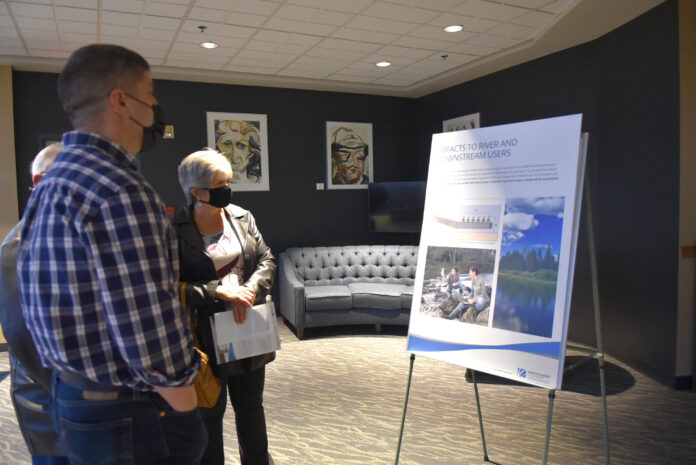
Northern wood is good for paper products and Paper Excellence is banking on the fact that it is also good for making cardboard packaging, paper towel and tissue paper as it plans to open the mill it owns at the edge of Prince Albert.
The mill hosted a come and go open house on Oct. 21 at the EA Rawlinson Centre as part of its work in meeting environmental requirements.
“The primary purpose of tonight is to collect any feedback or questions to incorporate into our environmental impact statement as part of our environmental assessment process,” said Carlo Dal Monte, VP of Business Development, Energy and Project Operations Director for the mill restart project.
“Fundamentally, we’re getting the mill ready to run.”
While the mill in its previous incarnation was a pulp mill, it made copy paper and produced pulp but the new owners are focused on new trends and on Asian markets.
“The interesting thing about northern wood species is that it is a valued product because it’s very strong,” said Dal Monte. “The primary market is in tissue, paper towels and also in specialty packaging, where you need something that’s strong and its renewable to support these lighter basis weights.”
As the world shifts to a higher priority on not using plastic or other hydrocarbons, focus has turned back to wood as a biodegradable, more natural product that can do some of the things plastic has been doing for years.
“When you see the decline in paper and digital displacement, you’re also seeing a dramatic growth in packaging and tissue. You’re seeing a growing middle class in a lot of parts of the world. With a growing middle class, you get consumption of paper products but not in the conventional means,” Dal Monte explained. “You’re talking tissue, towels. We’re starting to see communities are under pressure with recycling programs. Anything that’s renewable and compostable.”
The company plans to start construction in the spring to make the needed changes and will gather its wood source from other milling operations in Saskatchewan.
One-third of its supply will be residual from other mills and the remaining two thirds will be unusable wood that is harvested by companies cutting for things like 2x4s. The ‘round wood’, as it is referred to, is the tops of trees or those that are harvested but are not usable to make a length of lumber.
“One of the challenges of forestry in Saskatchewan, when the forestry companies go into a piece of land if they can only recover a certain percentage…it’s not great for the forest base itself,” said Dal Monte.
“All over the world, pulp and paper mills have always been complementary to sawmills and that’s what it was before so we’re hoping to restore that balance.”
Along with the re-opening of the pulp mill next to Prince Albert, the construction of a new oriented strand board near the city was announced this fall along with larger timber cut allocations in multiple existing mills, like the one in Big River and in Carrot River.
“One of the things that is interesting about the forest in Saskatchewan is that it is mixed stands. You have hardwood and softwood together. There are some businesses that are more suited to hardwoods and some businesses that are more suited to softwood,” explained Dal Monte.
“It’s complicated but I think they did a good job of threading the needle and coming up with the solution.”
Paper Excellence plans to have the mill producing pulp by the end of 2023 and to be fully operational shortly after that.
“Right now we’re still on track,” he said. “That’s part of what tonight is all about. Collecting all that feedback and making sure we have as fulsome application with the ministry.”
Dozens of people were at the open house when it started and Dal Monte had not heard a lot of concerns raised.
“The people I’ve been talking to, it’s more about what are the opportunities for local businesses? What are the opportunities for Indigenous businesses and what’s our procurement strategy?” he said. When we look at being inclusive, how do we embed that in hiring and in procurement. It’s good feedback.”
“In a way, the message we’re hearing is we want this to open and we’re here to help. Which is a great message for us to hear.”

